The Kitchen Readings (8 page)
Read The Kitchen Readings Online
Authors: Michael Cleverly

Photograph of Hunter taken by Liz Treadwell at an occasion involving less tension than the ill-fated Thanksgiving dinner.
Hunter used to do this trick in which he would put some lighter fluid in his mouth and squirt it out between his teeth while igniting it. It created an impressive stream of flame. This was the trick he was performing just as one of the dogs came charging up to him seeking a little affection. The result was a line of fire straight down the dog's back from the base of its neck to its tail. The dog screamed, Liz screamed, Hunter screamed, everyone else either jumped straight into the air or froze in place. The flaming dog bolted for the door that Liz opened just in time for the animal to charge through and roll crazily in the snow.
Fortunately the dog was uninjured. The lighter fluid burned so fast it never got down to the hide. After the initial shock, the
boys regained their composure and, in the spirit of true professionalism, acted as if nothing at all had happened and went back to whatever joke they were telling or conversation they were having before the conflagration. No one commented on the event at all. Hunter never apologized. The nauseating stench of burned dog hair that permeated the room was never acknowledged as the happy group finally sat down to the traditional Thanksgiving dinner Liz had spent so much time preparing.
Â
Liz tells the story about her good friend Fiona who returned to Aspen after an extended stay in Australia and rented a house across the road from Hunter. Soon after taking up residence, Fiona called Liz and told her that there were mice everywhere. Liz told her to get a cat. Fiona knew that Liz had an inventory of cats and asked if she could borrow one. Liz explained that you don't loan out your cats and that Fiona should go to the animal shelter and adopt one. For some reason Fiona was determined to borrow a cat instead of adopting, and actually managed to find someone to loan her one. It was huge, fifteen pounds of black and tan stripes, white chest, and a black mask just like a raccoon's, a real mouse terminator. The cat did fine work, and before long Fiona's mouse issues were a thing of the past.
While there were plenty of mice to hunt, the cat was happy to stay close to home, but when it finally ran out of prey it started to explore the neighborhood. One night it found its way on to Hunter's deck. The peacocks pitched a fit; they had no idea what to make of a cat the size of a Volkswagen.
The next morning Fiona opened her door, and in staggered the cat, beaten and bloody. She rushed the poor beast to the vet to find that it was riddled with birdshot. The cat survived but sustained some permanent brain damage, and the vet's bill
was well into four figures. HUNTER, WHY THE FUCK DID YOU SHOOT MY CAT? was the phrase heard echoing through Woody Creekâ¦more than once. The thing was, it wasn't Fiona's cat; it was a loaner. She had been given this huge, beautiful mouse-killing machine and now had thousands of dollars in vet bills and a cat who wasn't quite the same as when she'd borrowed it. As usual Hunter admitted nothing. He had absolutely no idea what she was talking about. Cats that looked like raccoons? Sounded pretty far-fetched to him.
Fiona paid the vet nonetheless, the cat's owners were displeased, and the poor addled cat led a very pampered life to the end of its days.
It was mid-afternoon, about three thirty; I was in my office. The phone rang, and it was Hunter. He and his assistant, Deborah, were at the bar at the Jerome.
Through the eighties and nineties, Deborah Fuller was Hunter's director of operations, hostess, executive secretary, bouncer, and mother. She lived in the cabin next to his house. As part-time assistants and lovers came and went, Deborah remained the constant, a woman beyond price and without whom nothing could happen at Owl Farm. On his own, Hunter was helpless. Deborah knew all and did all; she was loyal, fierce, and loving. She was the gatekeeper and the game warden. She knew Hunter better than anyone, and made it all work.
That afternoon Hunter asked me if I would care to join them. Of course I would. The Jerome had been Hunter's campaign headquarters in 1970 and the hundred-year-old bar with high ceilings, a cracked tile floor, and great views through huge windows was a favorite of us all. The bar is a block away from the courthouse where I had my office, so I said I would meet them in five minutes. I walked in, pulled up a stool between them, and bummed a Dunhill from Hunter. The J-Bar was the last establishment in Aspen that still allowed smoking, a prerequisite for Hunter's business. It also boasted a Tom Benton
THOMPSON FOR SHERIFF
poster on the wall.
Tom Benton had been one of Hunter's best friends for forty years. His art was political and strong. Mostly silk-screen prints, in limited editions, his posters supported candidates or causes, or were against war. Hand-carved letters spelling out quotes like “Eat the rich” or “First we kill all the lawyers” mixed with beautiful graphics and color.
The
THOMPSON FOR SHERIFF
posters featured a double-thumbed fist clenching a peyote button, and decades after the election they were still in demand. Hunter had a deal with Benton. Hunter believed that he owned the art. He had been right there when the poster was conceived and probably had as much to do with the look of the thing as anyone. Hunter had his own very specific notions about graphics and design and wasn't shy about scribbling away on anyone's work, whether it was Tom Benton's or Ralph Steadman's. He would give Benton 50 percent of any revenues generated by the sale of the posters that Benton screened in his studio. The posters were available in some galleries and on the Internet. If the art was signed by Hunter, the price per poster went from one hundred dollars to three hundred dollars.
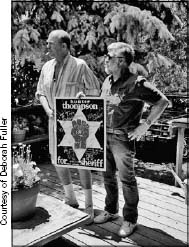
Hunter with Tom Benton and an
HST FOR SHERIFF
signed for outgoing police chief Tom Stephenson.
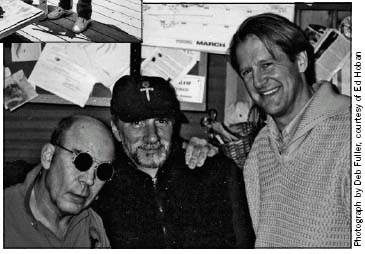
Kitchen camaraderie with Doc, Ed Hoban, and artist Paul Pascarella, codesigner of the fist logo.
Tom Benton's wife, Marcy, handled the money end of their poster business. She would deliver product and get the dough, more or less treating the whole thing like a drug deal. Benton stayed in the studio or worked for me as an officer in the Pitkin County jail.
One night, years before, while Benton was on duty in the jail, Hunter called him to ask if the jail had cable. Yes, the jail had cable TV; Owl Farm didn't. There was a title fight available only on cable and at nine thirty that night the inmates were locked down. Hunter came to the jail with his Dunhills and Chivas, and he and Benton watched the fight. It was a good measure of their friendship.
Anyway, Hunter, Deborah, and I were sitting at the bar when Joey DiSalvo, my chief detective and a friend of Hunter's, walked in. He was carrying a signed poster, recently purchased from Marcy Benton. It was signed not by HST, but by Marcy Benton. In gold Magic Marker. It was an obviously butchered attempt to replicate Doc's signature. When Joey unrolled the forgery, Deborah sighed. “That bitch.” I grinned, and Hunter started fuming.
Throughout his career Hunter felt that he had been ripped off by agents, publishers, and business managers. His paranoia and perception made him a wolverine if he had anything in his hands resembling evidence. He now had some serious evidence.
I said that Tom probably didn't know that Marcy might be signing art with Hunter's “HST.” Hunter's only focus was on the two hundred dollars he was losing and the fraud that had been perpetrated upon the buyer. We ordered another round of drinks, and Hunter promised Joey an authentic version. I happened to glance at the rear entrance to the bar, and there was Marcy walking with a man in a suit and tie. She was carrying a heavy roll of papers under her arm. It had to be business. She and the client sat at a table directly behind us, oblivious to our presence. She was making a deal.
I leaned forward, elbows on the bar, and whispered to Hunter and Deb, “Don't look now, but you won't believe who just
sat down behind us.” Of course Deb and Hunter immediately craned their necks and looked over their shoulders toward the table. Marci caught the glance and waved daintily. Who could believe this? Well, Hunter could. With creaky motions, he slid off the stool and stood. I said, “Hunter, don't do anything you'll regret.” Hunter sauntered over to Marcy and the mark. His voice rose, and Marcy blushed. She quickly gathered her art and exited through the door that she had come in, with the “suit” in tow.
Hunter had been involved in more than a few brawls in this very bar, and a simple yelling match instead of a donnybrook suited me fine. Hunter ordered more drinks, asked the bartender for a pen, and started writing something on a napkin. I walked out the rear door and into the lobby. Out there, I spotted Marci, handing the man in the suit four “signed” posters and taking twelve hundred dollars in cash. I approached them and said to the man, “I'm sure Hunter told you that this isn't his signature.”
“Yeah,” he said, “that is clear. But I'm from Hong Kong, and the art is good and the people to whom I'm giving these as gifts don't know that Hunter didn't sign them.” He said goodbye and went to his room. I gave Marci the “stink eye.” She smiled and left the hotel.
When I returned to the bar, Hunter was still scribbling on the napkin, biting his tongue as he often did while creating. He eventually slid over to me what he had written: “Hey, Rube! This is a public warning that there is an active trade in forged art in Aspen, Colorado. Beware of making any purchase of any Hunter S. Thompson for Sheriff posters from a freak-like skank with black hair and a high blood-alcohol content.” That was just for starters. It went on and got meaner. I asked him what he was going to do with it, and he said that he was going to place an ad in the
Aspen Times.
Fortunately for all of us, his warning never appeared in print.
Hunter's digital weekly column, published by ESPN.com, was entitled “Hey Rube.” I always considered it an homage to that day's rage.
Tom Benton recently retired, for the third time, from his detention deputy position. His marriage to Marcy continued, and he also continued to make beautiful art. He crafted my campaign poster for the 2006 election. (I, unlike Hunter, was victorious, by the way.)

Hunter toiling away on a “Hey, Rube” column.
Deanna Gay rolled into Aspen in the sixties. A hot, sixteen-year-old ski racer, she took one look around and instantly knew that she was home. Everyone called her DeDe. Back then in Aspen a lot of the streets were still dirt and there were few stoplights; there were no rules, all victimless “crimes” seemed legal, love was in the air, and no one's dictionary contained the term
statutory rape.
In some ways, it was paradise.
Skiers have always marched to the beat of their own drummers, and the faster you skied, the less you worried about what anyone thought. DeDe skied very fast, and while others were trying to keep up with the haute ski couture of the moment, she could be seen screaming down Aspen Mountain in plaid wool
Bermuda shorts and argyle knee socks. She blew away the best skiers and caught the attention of every lecher in town.
DeDe was a freshman at CU and ski-racing was the point of her being there. Her coach was ski legend Bob Beattie. His skiers and a lot of other people called him Coach; some of us called him Beats; to the world he was Mr. Skiing. He's largely responsible for the sport being what it is in the United States today. Hunter called him neighbor. Beattie moved in across the street from Hunter, and a friendship began that was as close as it was unlikely.
Â
Young DeDe would watch Hunter holding court at the end of the Jerome Bar. Surrounded by friends, acolytes, and awestruck tourists, he seemed oblivious to her. Was it possible that Hunter Thompson was the only straight male in Aspen who wasn't trying to figure out how to get her into a snow cave? Or was he just playing it particularly cool? Either way, DeDe was not amused. She began to scheme.
Vodka gimlets were the popular drink of co-eds at the time, and that is exactly what she proceeded to pour down her sexy, underage gulletâ¦in quantity. Finally emboldened, she headed for Hunter's end of the bar, set to get an invitation to Owl Farm. Amazingly she wasn't having much success until a mutual friend, Chris Hanson, came into the picture. Chris was handsome, tanned, and had a great Cheshire cat smile. He was a ski instructor and a cowboy. He could hold his own with Hunter drinking or doing whatever else came up. He could also hold his own roping, riding, and shooting, and was great with a bullwhip. After a whole bunch more drinks, it was decided that Chris could take a cigar out of DeDe's mouth with a whip. This experiment could only be done at Owl Farm, a small victory for DeDe. Off they went with brains full of booze and hearts full of pure science.
DeDe stood gamely in front of the stone fireplace in Hunter's living room with a sacrificial Cohiba clenched between her teeth. She signaled the cowboy to proceed, hoping to impress Hunter with her fearlessness. No one present was more surprised than DeDe when there was a loud crack and the cigar simply disappeared. She was also fairly surprised that her face was still exactly where it belonged. Hunter must have been a little impressed as he took things to the next level. He bellowed, “Do you shoot, whatever your name is? And if you do, would you like to step outside and fire off a few rounds?” Thrilled beyond reason, DeDe answered that of course she shot. “Grandpa had a duck club. I've owned a gun all my life.”

Bob and the “fair and winsome” DeDe (Deanna Gay) Brinkman.
Hunter was happy; this new one had spunk. “Let's put a few things on top of this propane tank,” he said. “You can have the first shot. Don't mind propane, do you, young lady?” “Of course not. My dad was a gas man; I adore propane,” DeDe gushed. Basically Hunter was hoping that the new girl would have enough sense to be scared to death by the prospect of shooting bottles off a five-hundred-gallon propane tank. In truth, DeDe's daddy actually was in the gas business and she knew that it would take a lot more muzzle velocity than what they were shooting with to penetrate the tank. Hunter did mention that it would be great if she didn't “point that fucking thing
at me!” All the years in the duck blind hadn't prepared her for shooting under these conditions. She was winging it.
Things went well that afternoon, everyone had a good time, but the young ski goddess didn't become the fixture in the kitchen that she had hoped to be. This was probably for the best, as sometimes the kitchen had a bad effect on young people who hadn't developed their calluses. Years went by, and DeDe and Hunter enjoyed a nice friendship that didn't much involve him trying to get her into a snow cave.
Â
In the eighties, the Aspen Art Museum started to have fundraisers in the form of art cart derbies. These were soapbox derbies for artists and pretty much anyone else with enough time on their hands to build gravity-powered racers. The course ran down Aspen Street from the bottom of Aspen Mountain's chairlift 1A to Main Street. That means it was steep and fast. The contests were judged on more than speed, though. Artistic merit, sexiness, and a number of other categories were just as important as velocity. There were spectacular crashes and questionable behavior of every sort. Naturally the event was wildly popular, drawing huge crowds and even national TV coverage.
Part of the event's popularity was the celebrity involvement; this was where DeDe came in. By the mid-eighties, she was close to the art crowd and the museum, and also deeply involved with Aspen's Hollywood expatriates. DeDe convinced her old coach Bob Beattie to announce the race. She recruited celebrity judges such as Michael Douglas, George Hamilton, and Emmy-winning screenwriter Tracy Keenan Wynn. The artist Tom Benton and then-sheriff Dick Kienast were also judges. A great lineup, but people wanted Hunter; this thing was custom made for Hunter. DeDe, it seemed, was the only girl for the job. Get Hunter.
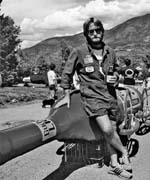
Carter and the Stoli bottle, morphed into a Bud bottle. Art carters were shameless sluts and would alter their carts to accommodate anyone with an open checkbook.
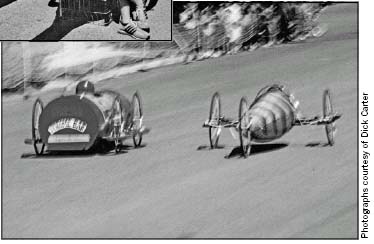
Race action.
At first Hunter was cagey. “I won't have to go on TV with George Hamilton, will I?” Hunter would soon learn that Hamilton was a very decent and hip guy. Hunter was basing his opinion of George on an image as carefully crafted as his own. DeDe tried to explain this to him, but Hunter always had to figure things out for himself, so she finally just conceded that Hunter wouldn't
have to go on TV with anyone he didn't want to. Ever the negotiator, Hunter then demanded a more or less unlimited supply of liquor and drugs. This surprised no one, and had already been factored in as part of the cost of doing business. Whose budget it came out of, no one tells. It would have been difficult for Doc to blow the thing off; too many of his buddies were involved: Beattie announcing, Benton and Kienast judging, and artists Dick Carter and Michael Cleverly both racing in the competition.
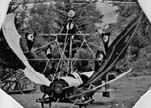
Cleverly's Death Bat.
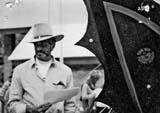
George Hamilton, awed by the Death Bat.
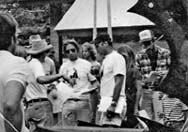
Michael Douglas, Tracy Keenan Wynn, and Doc, judging the entrants.
Carter had somehow conned a liquor distributor into sponsoring his racer. He built a huge fiberglass bottle of Stolichnaya vodka. It was very fast, and its great weight made it a potential hazard to both driver and spectators. All of the contestants needed to have steering and brakesâbut the two weren't exactly at the top of anyone's list.
Cleverly was the team captain and driver for the Fedaykin Death Commandos, a group of prominent Aspenites who were successful, solid citizens on the surface but still depraved exhippie frat boys somewhere beneath and who had had the wherewithal to finance the Fedaykin Death Bat. They had stolen their name from the sci-fi classic
Dune.
Built by Cleverly and
Aspen Times
ace reporter Andy Stone, the Death Bat was a cross between a dragonfly, a square-rigger, a bat, and a biplane. It had multiple wings, propellers, and complicated masts and rigging. It looked dangerous and threatening. The logo for the Fedaykins was a high-tech skull with wings. The image most people associated with them was the baby blue nitrous oxide tank with several hoses extending from it that they kept in the pit area.
By the end of race weekend, DeDe had gained a lot of credibility with Hunter. He had a terrific time, spending as much of it as possible in the Fedaykin pit area with the nitrous tank. The fact that he was a judge prompted a few complaints of potential bias that were largely ignored. In point of fact, the Fedaykins had thoughtfully provided the announcers and all the judges with Fedaykin team uniforms. The announcers' T-shirts sported the Fedaykin logo with
BIASED ANNOUNCER
written underneath, and the judges' T-shirts had the words
CORRUPT JUDGE
under the logo. Kienast's T-shirt bore a skull with
CORRUPT SHERIFF
. The idea of favoritism was pretty much a moot point. On the back,
the shirts all carried the slogan
SAFETY THIRD
. Hunter was happy: there was blood on the pavement and there were drugs in the Doctor. DeDe was tops.
